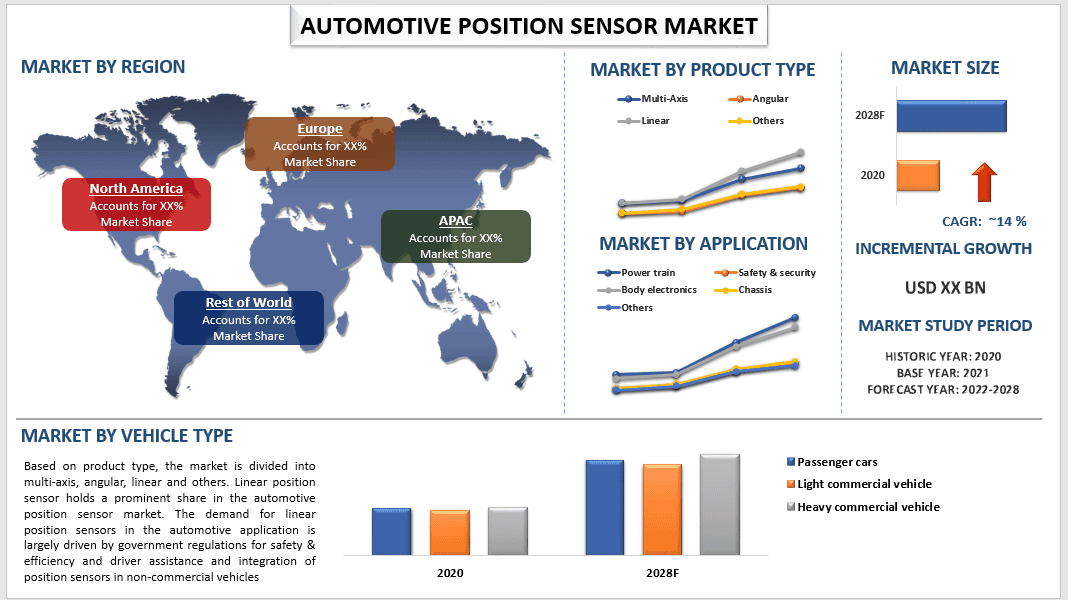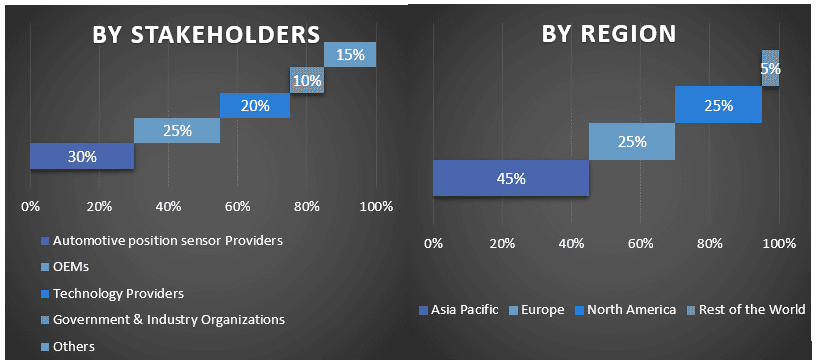- Inicio
- Acerca de nosotros
- Industria
- Servicios
- Leyendo
- Contáctenos
Mercado de sensores de posición automotrices: análisis actual y pronóstico (2022-2028)
Énfasis en el tipo de producto (multieje, angular, lineal y otros); tipo de vehículo (automóviles de pasajeros, vehículos comerciales ligeros y vehículos comerciales pesados); tipo de aplicación; (tren de potencia, seguridad, electrónica de la carrocería, chasis, otros) y región/país

SOLICITAR PDF DE MUESTRA GRATUITO
Se espera que el mercado mundial de sensores de posición automotrices crezca a una tasa significativa de alrededor del 14% durante el período de pronóstico. Los sensores de posición se utilizan en automóviles para determinar la posición del volante, las posiciones de los pedales, las posiciones de los asientos y la posición de varias válvulas, perillas y actuadores. Estos sensores utilizan una variedad de tecnologías, como potenciómetros de brazo limpiador, reflexión o imagen óptica y sensores de efecto Hall, para detectar su ubicación. Con los continuos avances e innovaciones en la tecnología, la demanda de opciones de conducción más convenientes y fáciles conducirá a una creciente demanda de sensores electrónicos en el mercado automotriz. La creciente inclinación de los consumidores hacia vehículos de combustible alternativo para reducir las emisiones de GEI y el aumento de la demanda de los consumidores por la seguridad de los vehículos son otros factores que impulsan la demanda de sensores automotrices en todo el mundo. Por ejemplo, en EE. UU., los registros de nuevos vehículos eléctricos se dispararon un 60 % en los primeros tres meses de 2022, aunque los registros de automóviles nuevos en realidad bajaron un 18 % en general, informaron Automotive News y Car and Driver, citando datos de Experian. Los vehículos eléctricos ahora representan el 4,6 % de todos los vehículos de pasajeros que se venden en los EE. UU.
Analog Devices Inc., Broadcom Inc., Bosch Sensortec Gmbh, Bourns Inc., Continental AG, CTS Corporation, BorgWarner Inc., DENSO CORPORATION, HELLA GmbH & Co e Infineon Technologies AG. son algunos de los actores clave en el mercado. Estos actores han emprendido varias fusiones y adquisiciones junto con asociaciones para facilitar a los clientes productos/tecnologías innovadores y de alta tecnología.
Perspectivas presentadas en el informe
“Se prevé que, entre los tipos de productos, la categoría de línea tenga una participación destacada durante el período de pronóstico”
Según el tipo de producto, el mercado se divide en multieje, angular, lineal y otros. El sensor de posición lineal tiene una participación destacada en el mercado de sensores de posición automotrices. La demanda de sensores de posición lineal en aplicaciones automotrices está impulsada en gran medida por las regulaciones gubernamentales para la seguridad y la eficiencia, la asistencia al conductor y la integración de sensores de posición en vehículos no comerciales.
“Entre los tipos de vehículos, el segmento de automóviles de pasajeros tendrá una participación significativa en el mercado en 2020”
Según el tipo de vehículo, el mercado se divide en automóviles de pasajeros, vehículos comerciales ligeros y vehículos comerciales pesados. El segmento de automóviles de pasajeros tiene la mayor participación por tipo de vehículo. El crecimiento del segmento está impulsado por la creciente popularidad de los vehículos eléctricos, híbridos y autónomos.
“Entre los tipos de aplicaciones, se prevé que el segmento del tren motriz tenga una participación destacada durante el período de pronóstico”
Según el tipo de aplicación, el mercado se divide en tren motriz, seguridad y protección, electrónica de la carrocería, chasis y otros. El segmento del tren motriz tiene una participación destacada por aplicación. Las estrictas regulaciones de emisiones y las normas de eficiencia de combustible formuladas por los gobiernos de varios países impulsan el crecimiento de los sensores automotrices en la aplicación del tren motriz.
“Asia Pacífico tendrá una participación significativa en el mercado de sensores de posición automotrices”
Asia Pacífico dominó el mercado de sensores de automóviles automotrices en 2020 y se espera que represente el mayor crecimiento del mercado de sensores automotrices en los próximos años. Los principales factores que respaldan el crecimiento del mercado de sensores automotrices en la región de Asia Pacífico se deben a la gran cantidad de población y al crecimiento en la producción de vehículos comerciales, el aumento del poder adquisitivo del consumidor, la creciente demanda de vehículos más eficientes y seguros, el creciente uso de vehículos eléctricos y la creciente adopción de sistemas avanzados de asistencia al conductor (ADAS) y automóviles autónomos debido a los estrictos estándares de emisiones de vehículos.
Razones para comprar este informe:
- El estudio incluye un análisis de tamaño y previsión del mercado validado por expertos clave autenticados de la industria.
- El informe presenta una revisión rápida del desempeño general de la industria de un vistazo.
- El informe cubre un análisis en profundidad de los pares destacados de la industria con un enfoque principal en las finanzas comerciales clave, la cartera de productos, las estrategias de expansión y los desarrollos recientes.
- Examen detallado de los impulsores, las restricciones, las tendencias clave y las oportunidades que prevalecen en la industria.
- El estudio cubre exhaustivamente el mercado en diferentes segmentos.
- Análisis profundo a nivel regional y de país de la industria.
Opciones de personalización:
El mercado mundial de sensores de posición automotrices se puede personalizar aún más según los requisitos o cualquier otro segmento de mercado. Además de esto, UMI entiende que puede tener sus propias necesidades comerciales, así que no dude en conectarse con nosotros para obtener un informe que se adapte completamente a sus requisitos.
Tabla de contenido
Metodología de Investigación para el Análisis del Mercado de Sensores de Posición Automotriz (2022-2028)
Analizar el mercado histórico, estimar el mercado actual y pronosticar el mercado futuro del mercado global de sensores de posición automotriz fueron los tres pasos principales que se llevaron a cabo para crear y analizar la adopción de sensores de posición automotriz en las principales regiones a nivel mundial. Se llevó a cabo una investigación secundaria exhaustiva para recopilar las cifras históricas del mercado y estimar el tamaño actual del mercado. En segundo lugar, para validar estos conocimientos, se tomaron en consideración numerosos hallazgos y supuestos. Además, también se realizaron entrevistas primarias exhaustivas con expertos de la industria en toda la cadena de valor del mercado de sensores de posición automotriz. Tras la suposición y la validación de las cifras del mercado a través de entrevistas primarias, empleamos un enfoque de arriba hacia abajo/de abajo hacia arriba para pronosticar el tamaño total del mercado. Posteriormente, se adoptaron métodos de desglose del mercado y triangulación de datos para estimar y analizar el tamaño del mercado de los segmentos y subsegmentos de la industria en cuestión. La metodología detallada se explica a continuación:
SOLICITAR PDF DE MUESTRA GRATUITO
Análisis del Tamaño Histórico del Mercado
Paso 1: Estudio Profundo de Fuentes Secundarias:
Se llevó a cabo un estudio secundario detallado para obtener el tamaño histórico del mercado de sensores de posición automotriz a través de fuentes internas de la empresa, como informes anuales y estados financieros, presentaciones de desempeño, comunicados de prensa, etc., y fuentes externas, incluidos revistas, noticias y artículos, publicaciones gubernamentales, publicaciones de la competencia, informes del sector, bases de datos de terceros y otras publicaciones creíbles.
Paso 2: Segmentación del Mercado:
Después de obtener el tamaño histórico del mercado de sensores de posición automotriz, realizamos un análisis secundario detallado para recopilar información histórica del mercado y compartirla para diferentes segmentos y subsegmentos para las principales regiones. Los principales segmentos incluidos en el informe son componentes, protocolos y aplicaciones. Además, se realizaron análisis a nivel de país para evaluar la adopción general de modelos de prueba en esa región.
Paso 3: Análisis de Factores:
Después de adquirir el tamaño histórico del mercado de diferentes segmentos y subsegmentos, realizamos un análisis de factores detallado para estimar el tamaño actual del mercado de sensores de posición automotriz. Además, realizamos un análisis de factores utilizando variables dependientes e independientes, como el tipo de producto, el tipo de vehículo y las aplicaciones del sensor de posición automotriz. Se llevó a cabo un análisis exhaustivo de los escenarios de oferta y demanda, teniendo en cuenta las principales asociaciones, fusiones y adquisiciones, expansión comercial y lanzamientos de productos en el mercado de sensores de posición automotriz en todo el mundo.
Estimación y Pronóstico del Tamaño Actual del Mercado
Tamaño Actual del Mercado: Basándonos en información útil de los 3 pasos anteriores, llegamos al tamaño actual del mercado, los actores clave en el mercado global de sensores de posición automotriz y las cuotas de mercado de los tipos de sensores. Todos los porcentajes de participación requeridos y los desgloses del mercado se determinaron utilizando el enfoque secundario mencionado anteriormente y se verificaron a través de entrevistas primarias.
Estimación y Pronóstico: Para la estimación y el pronóstico del mercado, se asignaron ponderaciones a diferentes factores, incluidos los impulsores y las tendencias, las restricciones y las oportunidades disponibles para las partes interesadas. Después de analizar estos factores, se aplicaron técnicas de pronóstico relevantes, es decir, el enfoque de arriba hacia abajo/de abajo hacia arriba, para llegar al pronóstico del mercado para 2028 para diferentes segmentos y subsegmentos en los principales mercados a nivel mundial. La metodología de investigación adoptada para estimar el tamaño del mercado abarca:
- El tamaño del mercado de la industria, en términos de ingresos (USD) y la tasa de adopción de sensores de posición automotriz en los principales mercados a nivel nacional
- Todos los porcentajes de participación, divisiones y desgloses de los segmentos y subsegmentos del mercado
- Actores clave en el mercado global de sensores de posición automotriz en términos de productos ofrecidos. Además, las estrategias de crecimiento adoptadas por estos actores para competir en el mercado de rápido crecimiento
Validación del Tamaño y la Cuota del Mercado
Investigación Primaria: Se realizaron entrevistas en profundidad con los Líderes de Opinión Clave (KOL), incluidos los Ejecutivos de Nivel Superior (CXO/VPs, Jefe de Ventas, Jefe de Marketing, Jefe de Operaciones, Jefe Regional, Jefe de País, etc.) en las principales regiones. Luego, se resumieron los hallazgos de la investigación primaria y se realizó un análisis estadístico para probar la hipótesis establecida. Los aportes de la investigación primaria se consolidaron con los hallazgos secundarios, convirtiendo así la información en conocimientos prácticos.
División de los Participantes Primarios en Diferentes Regiones

Ingeniería del Mercado
Se empleó la técnica de triangulación de datos para completar la estimación general del mercado y para llegar a cifras estadísticas precisas para cada segmento y subsegmento del mercado global de sensores de posición automotriz. Los datos se dividieron en varios segmentos y subsegmentos después de estudiar varios parámetros y tendencias en las áreas del tipo de producto, el tipo de vehículo y la aplicación en el mercado global de sensores de posición automotriz.
El objetivo principal del Estudio del Mercado Global de Sensores de Posición Automotriz
Las tendencias actuales y futuras del mercado del mercado global de sensores de posición automotriz se identificaron en el estudio. Los inversores pueden obtener información estratégica para basar su discreción para las inversiones en el análisis cualitativo y cuantitativo realizado en el estudio. Las tendencias actuales y futuras del mercado determinaron el atractivo general del mercado a nivel regional, proporcionando una plataforma para que el participante industrial explote el mercado sin explotar para beneficiarse de una ventaja de ser el primero en actuar. Otros objetivos cuantitativos de los estudios incluyen:
- Analizar el tamaño actual y previsto del mercado de sensores de posición automotriz en términos de valor (USD). Además, analizar el tamaño actual y previsto del mercado de diferentes segmentos y subsegmentos
- Los segmentos en el estudio incluyen áreas del tipo de producto, el tipo de vehículo y la aplicación.
- Definir y analizar el marco regulatorio para el sensor de posición automotriz
- Analizar la cadena de valor involucrada con la presencia de varios intermediarios, junto con el análisis de los comportamientos de los clientes y competidores de la industria.
- Analizar el tamaño actual y previsto del mercado de sensores de posición automotriz para la región principal.
- Los principales países de las regiones estudiadas en el informe incluyen Asia Pacífico, Europa, América del Norte y el resto del mundo.
- Perfiles de empresas del mercado de sensores de posición automotriz y las estrategias de crecimiento adoptadas por los participantes del mercado para mantenerse en el mercado de rápido crecimiento
- Análisis regional en profundidad de la industria
Relacionados Informes
Los clientes que compraron este artículo también compraron










